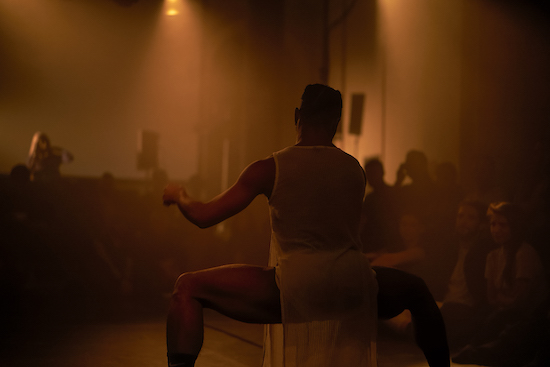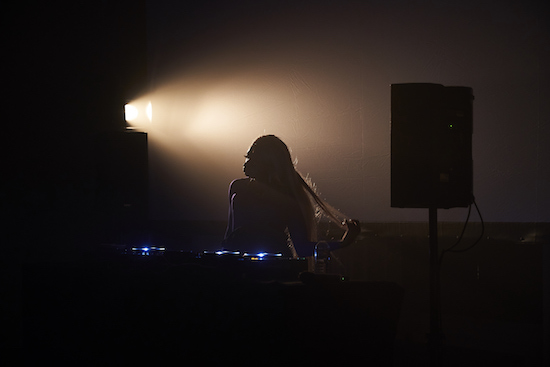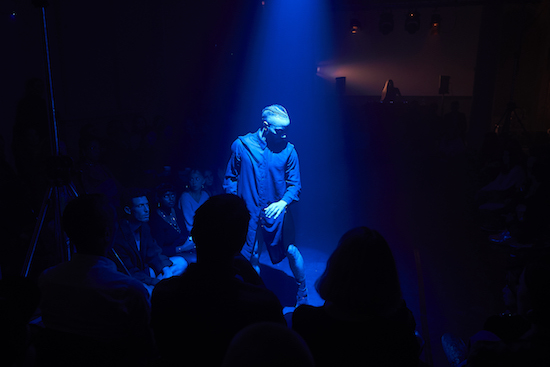All Embryogenesis photographs courtesy of Anne Tetzlaff
Somerset House is well known for holding artist residences in its warren-like space, particularly PJ Harvey’s Recording In Progress sessions where she worked on material live, surrounded by instruments, in front of audience separated from her only by glass. Launched in 2016, the more experimental dimension of the imposing complex separating The Strand from The Thames – Somerset House Studios – opens up the white-walled Neoclassical building to thoughtful and engaging audio visual practices and lectures that challenge our perceptions of the space itself.
It was only last month that art publication The White Pube recently posted a polemical essay titled I Literally Hate The Art World on the subject of who gets to use a gallery’s ‘white cube’, and who gets pushed away, who leads the conversation – this extends to all institutions seeking to maintain oppressive and exclusionary power structures within their walls.
The ASSEMBLY showcase appears to have been curated in part as an effort to subvert the House’s history, as it was originally commissioned by the Duke of Somerset to be home to the Royal Family in the 16th and 17th centuries, eventually becoming a site for King’s College London, Royal Academy exhibitions, The Courtauld Institute of Art and other arts councils. Is ASSEMBLY sincere in its efforts to ‘radicalise’ the space of Somerset House? It seems so from an audience perspective — the programme is well curated, placing together experimental performance artists, film screenings and lectures in a way that’s logical, cohesive and allows its artists to lead the conversation and visually manipulate the space in unorthodox ways.
ASSEMBLY mainly challenges Western conceptions of dance, but also includes a lecture from Jennifer Walshe, Paul Purgas, Andrea Zarza Canova and Frances Morgan on how artists can disrupt dominant narratives and histories within archives and collections. It’s safe to say there is little shrinking back here from artists and thinkers that challenge conventional Western (and at times heteronormative) approaches to performance art, even if that includes challenging the concept of collecting and archiving that Somerset House is also historically known for.
On the Friday of ASSEMBLY, ballet is one major Western convention that is challenged here through Lotic & Roderick George’s performance Embryogenesis. Here, experimental electronic musician Lotic provides the sub-bass littered ambient-influenced dance backing for the classically trained Roderick George’s ballet performance; their aim is to confuse the boundaries between “high” and “low” culture, challenging audience perceptions of who gets to perform certain forms of dance.
Back in 2016, Spanish dancer and dirctor of the English National Ballet Tamara Rojo and her choreographer Akram Khan challenged traditional Western-centric themes of ballet by interpreting Giselle from the perspective of a refugee, with Khan imbuing it with percussive influences from the Indian dance technique Kathak in which he was trained. Lotic & Roderick George’s experimental ballet performance feels far more intimate; the audience is positioned around George while he dances, either seated on cushions or low chairs. Interpreting Lotic’s beats requires dancing that’s extremely fast-paced, and although short-lived George demonstrates dramatic shows of physical contortion. While Khan takes a traditional Indian influence into ballet, George makes it fit for a nightclub, but with moments of more abstract expressionism. In what seems like the short space of half an hour, he achieves a lot – at one point he’s on the floor, humping a pillow, then he’s slinking back in fear at a beam of light directed from the ceiling, then he’s back on the floor again exhibiting physical spasms imitating a seizure. Time doesn’t seem to pass normally, with George displaying every human emotion going; putting himself under immense physical and psychological pressure, he’s playing the role of a method actor. Power relations too became blurred in this novel relationship between audience, dancer and Lotic hidden behind a desk away from the centre stage, providing prowling, sinister rhythms. In contrast, Lotic was stationary throughout the performance, sometimes coming down from the stage to meet George, holding his hand, though even onstage they looked every part the observer as the audience. Most of the time it seemed like Lotic was providing music for George, rather than taking a particularly central, figure role of musician-as-frontperson.

It’s hard to look at Jlin & Wayne McGregor’s Autobiography experimental ballet choreography here as a point of comparison, mainly because the way that the two artists present it constantly changes. some instances of the performance have been fairly traditional in terms of dynamic between audience and the dancers – with the dancers being onstage and the audience being in levelled seating. Jlin’s accompanying music is less footwork influenced and more focussed on sound sculpting and minimalist ambient compositions. So the dancer interpretation of Autobiography’s accompanying soundtrack is less straightforward in some respects than Roderick George’s interpretation of Lotic’s music, in that such a dancer would have to figure out how to dance to ambient music – all dancing requires an abstract interpretation of sound into movement, but this is more often than not done through the interpretation of rhythms or grooves.
Lotic & Roderick George’s Embryogenesis takes more from club venues than Jlin & Wayne McGregor, and in comparison Autobiography looks to be a lot less frantic a performance, with the dancer often responding more to the spacing in between elements, as well their articulation (how loud or quiet the elements are.) If anything, Roderick George’s performance Dust with his back in 2016 bears more resemblance to Autobiography, with their cluster of dancers swimming through a sea of drone and manipulated vocal textures provided by sound artists SAD aka Josh Johnson & Cyril Baldy. Even though Autobiography is very different to Embryogenesis in terms of its pacing and emotional atmosphere – Lotic & Roderick’s ASSEMBLY performance felt visceral, expressionistic, somehow more ‘close’ to the audience – but both show ways in which ballet can be taken in new and exciting directions by providing dancers with more challenging or unconventional musical cues.
During the Saturday and Sunday, ASSEMBLY loosened up, looking more like when the Tate Britain opens up in the evening for its Late At Tate events. ASSEMBLY does this better however – and it’s in part due to the acoustics of the place. The Tate Britain building is (for whatever reason) less suitable than Somerset House for bass (let alone sub-bass), with the mood of its live performances easily killed by the muddiness of its sound, as if the whole building had become somehow submerged underwater. Although at times the sub-bass in Somerset House’s rooms is just a little too loud, on the whole it works effectively as a venue for electronic music.
No longer seated like in Lotic’s performance, the crowd seemed more at ease say for instance during Okzharp & Manthe Ribane’s set in particular — they started to really collectively own it. Speaking idealistically, this buzz seemed to arise out of this completely fresh way of presenting a new divergent future for Somerset House; it opened up the idea of a parallel universe where its white cubes could be used and visually manipulated by artists that arts institutions previously shut off or denied on the basis of race, gender, sexuality or class. The atmosphere was quite similar to that of Utrecht’s highly eclectic Le Guess Who? festival but on a smaller scale, with exhibitions and performances being held simultaneously inside a single arts building. This was exemplified by DJ sets from Berlin techno producer Ziúr and Terribilis, both provided experimental female and non-binary record label Objects Limited DJ set at the Studios’ open bar. Terribilis aka Molly O’Reilly’s set in particular was all parts vigorous, raunchy, humorous and welcoming. O’Reilly was one of UNITI’s co-founders, a London-based platform for marginalised artists set up with alongside Siren DJs to counter the lack of LGBTQ+ friendly representation in nights that they were attending in London. During Terribilis’ set, there were moments when it seemed as if the plaster in the building’s frosted icing contours would break away from the sheer force of these vibrations, and that the room would crumble in an avalanche of dust. No longer threatening, the Neoclassicism of the Studios suddenly seemed a little camp.

Although Lotic & Roderick George’s Embryogenesis was the only “official” choreographed performance at ASSEMBLY, dance is present throughout the weekend. During the Egyptian-Iranian performance artist Lafawndah’s vocal-centric performance of ‘Joseph’ (written in collaboration with Midori Takada), dancer Saul Nash emerges slowly from the crowd. At first he is hidden inside the crowd itself, but there’s some stirring as we back away from the space he is in. It’s easy to view a crowd or large mass of people as a potential threat, but the way that it collectively handled Nash’s presence toys with that. The crowd facing Lafawndah then seemed to become uncertain, vulnerable and ultimately respectful of the space that Nash was now dancing in. Two women crouch on the ground, capturing his slow, graceful, deliberate gestures on their camera phones. As for the rest of us, we are leaning in at a slight distance, our attention solely fixated on the dancer. There is a degree of empathy present during Lafawndah’s performance that I’ve not felt in an audience for some time.
That all being said, there is something very enjoyable about South African multidisciplinary performance artist Manthe Ribane’s minimalist, robotic “showroom dummy” dance-moves. At first she’s emotionally distant from the audience, with the image of a latex-soul, space-visor wearing Afrofuturist pop star fitting her like a shiny black glove. There’s robot dancing, and then there’s robot dancing of the uncanny-valley kind that Kraftwerk achieved. Musically, the pairing of Ribane and Okzharp’s tastes range from Björk to Sun Ra to footwork, and their interpretation of this leads them into a warm, spacious experimental R&B territory. Ribane only keeps up the distance from her audience for so long — as soon as she takes of her visor, her movements become looser, her interactions with the audience more personal, fitting into the ASSEMBLY atmosphere of bringing crowd and artist alike together into something gently co-participatory rather than alienating and hierarchical. While, of course, reminding the audience of both the building’s potential for alienation and hierarchy; at first it seems confusing to experience these performances inside of Somerset House Studios. And that’s because being in it, you are reminded of grandeur’s power to alienate and oppress people it has not personally invited. But over the course of ASSEMBLY, you get the sense of this power being exorcised, pushed back underground. Although it does well to address the lack of women and femme friendly LGBTQ+ space in London through its hosting of Siren DJs, one area ASSEMBLY could have done slightly better in is drawing more on small, less well-funded, developing performance arts communities in London that still require support and visibility.


